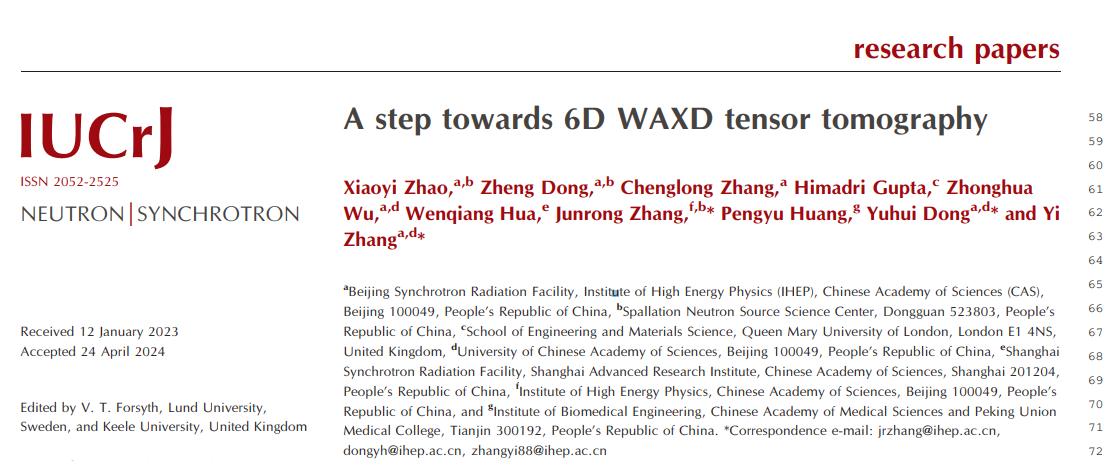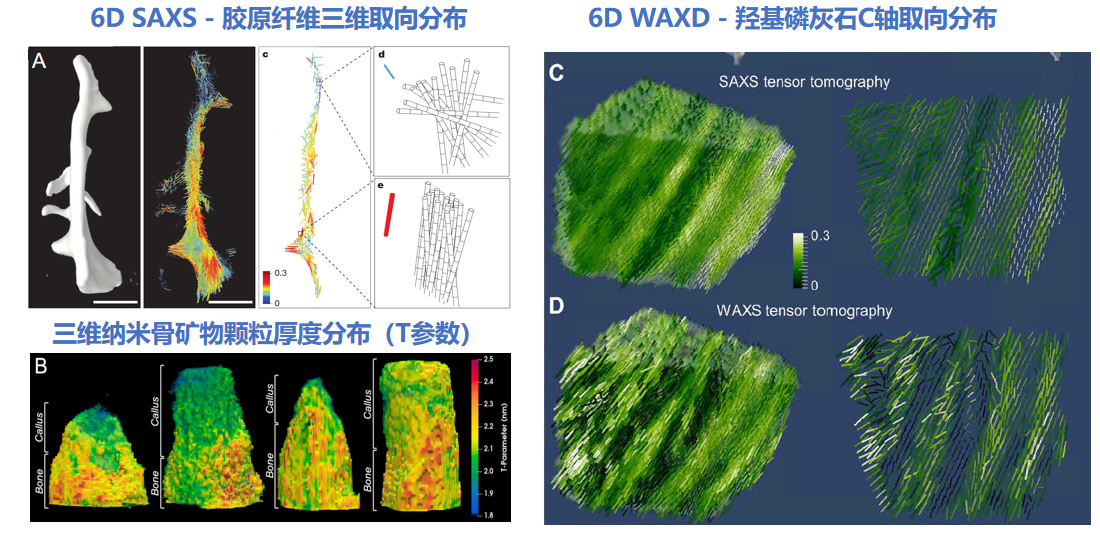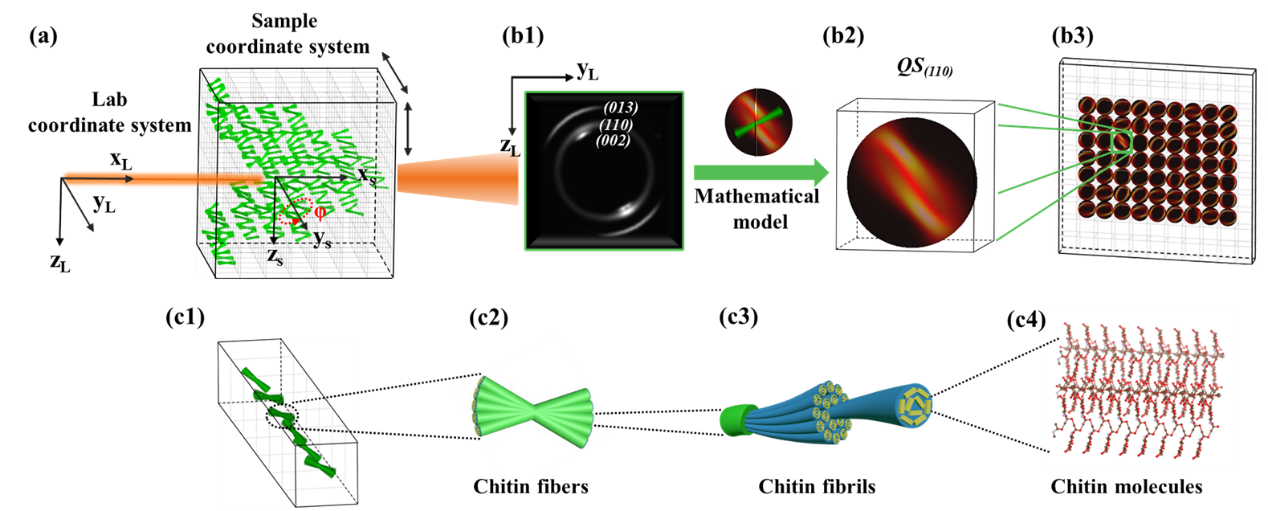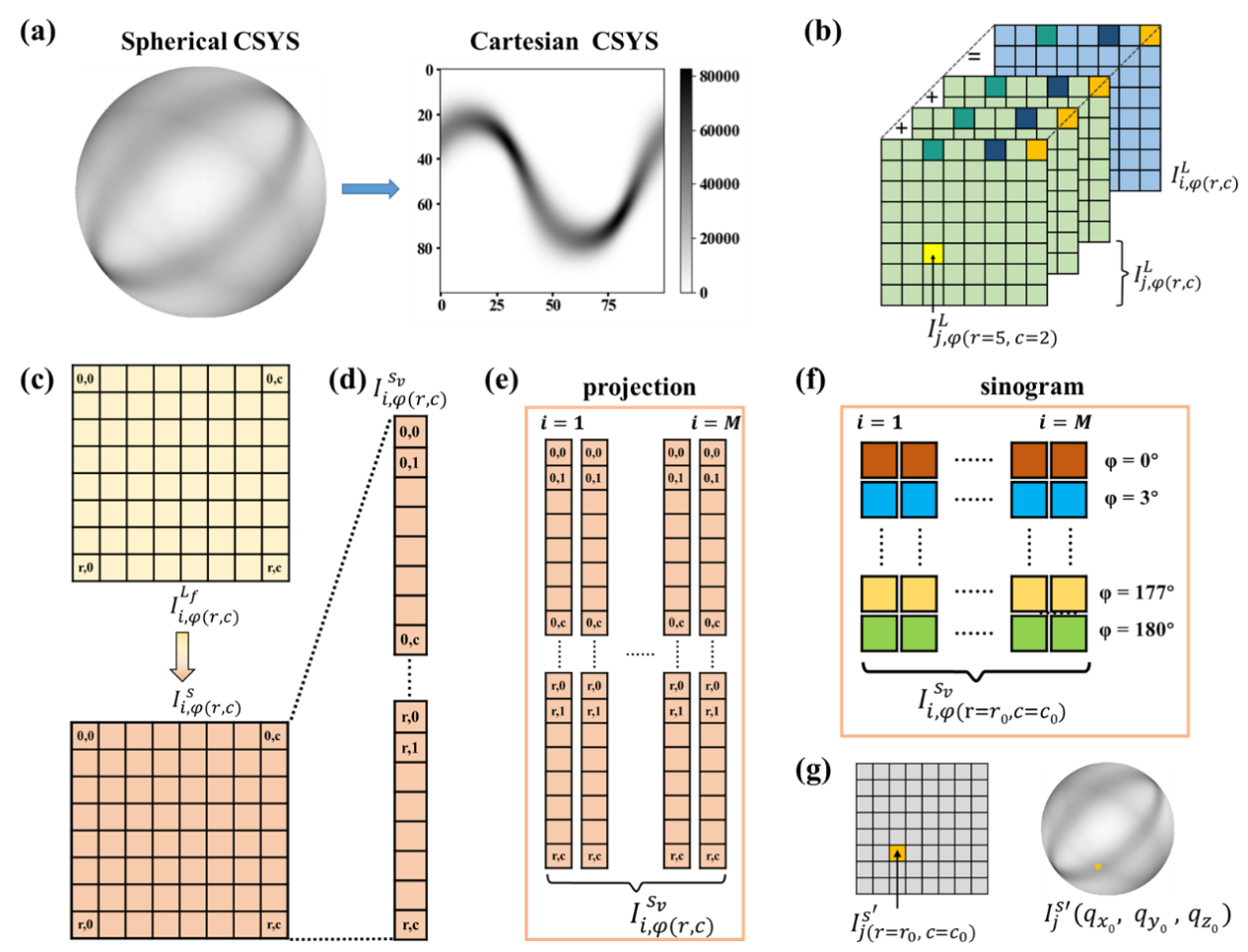Recently, Zhang Yi's group of the Institute of High Energy Physics of the Chinese Academy of Sciences published a research paper entitled "A step towards 6D WAXD tensor topography" on IUCrJ. This work introduces a new method for six dimensional diffraction tensor tomography based on virtual reciprocal space scanning, and simulates the entire process from data acquisition to reconstruction to verify the accuracy and feasibility of the method.

Synchronous Radiation Small Angle X-ray Scattering (SAXS) and Wide Angle X-ray Diffraction (WAXD) are important characterization methods for the multi-scale microstructure and mechanical properties of biomaterials and synthetic materials. However, the sample information obtained from conventional SAXS and WAXD experiments (such as phase, grain size, crystal orientation, stress and strain magnitude, etc.) is the average value within the volume of X-ray irradiation, lacking spatial resolution in the direction of incident light. The SAXS/WAXD Tomography technology, which combines X-ray computed tomography (CT) with SAXS and WAXD technologies, can obtain multiple structural information for each voxel, solving the problem of traditional SAXS/WAXD lacking spatial resolution of incident light direction. In traditional X-ray CT imaging, each voxel is a scalar parameter information, such as the density information of bones. For anisotropic samples, especially those with high orientation such as bones, muscles, shrimp shells, and shells, in order to obtain internal three-dimensional orientation and tensor distribution information such as stress-strain, and achieve multi-scale characterization of graded biomaterials, it is necessary to conduct six dimensional scattering/diffraction tensor imaging (6D SAXS/WAXD Tensor Tomography) experiments, which require scanning of six dimensions of information in real space and reciprocal space. This type of experimental method is also known as X-ray Tensor Tomography.
In 2015, Franz Pfeiffer and Marianne Libei's research groups published articles respectively in the journal Nature(Liebi et al., 2015; Florian Schaff et al., 2015), At the same time, a conceptual validation work was reported on the use of 6D SAXS Tomography methodology to characterize the orientation distribution of nanofibers inside different types of graded biomaterials (teeth, bones), which has led to widespread attention on X-ray scattering/diffraction tensor imaging technology. However, in order to meet the rotational invariance required for Tomogram reconstruction, six dimensional scattering/diffraction tensor imaging needs to collect information from six dimensions, including real space and reciprocal space. The experimental process first requires three-dimensional scanning of the sample in real space, and each scanning point needs to further rotate the sample to collect information from reciprocal space. The multi-dimensional scanning process is time-consuming, and currently, it takes nearly 40 hours to complete a set of 6D SAXS Tensor Tomography scanning experiments with four dimensions (horizontal, vertical, φ, and θ) at the cSAXS line station of Swiss Light Source (SLS), which causes significant radiation damage to the sample and cannot be used for in situ characterization, greatly limiting the practicality of this technology in materials science research. And due to the sensitivity of WAXD intensity distribution in reciprocal space to angle changes compared to SAXS, higher sampling reciprocal space information scanning is required to achieve complete 6D information collection. Therefore, current research on X-ray Tensor Tomography methodology mainly focuses on SAXS. In recent years, multiple research groups have reported progress in algorithm optimization and application of scattering/diffraction tensor imaging (Liebi et al., 2018, Gao et al., 2019, Guizar-Sicairos et al., 2020, Tilman A. Grünewald et al., 2020, Elisa A. Casanova et al., 2023). The above methods simplify the scanning process of reciprocal space and the accuracy of voxel reconstruction to a certain extent, but cannot fundamentally solve the problem of poor data collection timeliness caused by multi-dimensional scanning.

The new method is based on the concept of "virtual inverted space scanning", which reduces the scanning dimension of the original six dimensional tensor tomography from four to three dimensions, greatly improving the timeliness of data collection. It also successfully extends the original 6D SAXS method to 6D WAXD, improving the reconstruction accuracy and application range The core of "Virtual Inverted Space Scanning" is to use diffraction physical models to extract three-dimensional reciprocal space information hidden in 2D WAXD experimental spectra, in order to replace the original inverted space scanning process (Figure 2). In order to verify the feasibility and accuracy of this method, this paper conducted a full process simulation modeling of the six dimensional tensor tomography experimental method. Based on a simulated diffraction dataset, the process of 1) extracting three-dimensional inverted space information (virtual inverted space scanning), 2) reconstructing three-dimensional inverted space, and 3) extracting three-dimensional fiber orientation parameters of the method was validated. The test results showed that the new method can accurately extract the three-dimensional fiber orientation information using three dimensional scanning data.

To address the challenge of reconstructing three-dimensional inverted space, the research team proposed a distributed reconstruction strategy (Figure 3). This strategy solves the problem of rotational invariance in the inverse space of anisotropic materials in the laboratory coordinate system. At the same time, by transforming the 3D reciprocal space into a 2D tensor in the Cartesian coordinate system, and then into a 1D tensor, a distributed reconstruction strategy is used to reconstruct the 3D reciprocal space of voxels using the FBP algorithm, obtaining voxel information in the 3D real space and 3D inverse space, and achieving 6D reconstruction of the sample. Finally, the feasibility of this method was verified by comparing simulated data with reconstructed data (Figure 4).


In summary, the optimization of the algorithm is expected to greatly improve the timeliness of the six dimensional diffraction/scattering tensor imaging method, thereby facilitating in situ characterization and research on radiation sensitive samples. With the emergence of new generation synchrotron radiation light sources such as high-energy synchrotron radiation (HEPS), X-ray brightness and detector performance have been greatly improved. It is expected to conduct experiments with high (data) flux, multimodality, ultrafast frequency, in situ and dynamic loading. The collection time of millions of frames of diffraction data can theoretically be compressed to within one hour, making it possible for the characterization method of six dimensional diffraction tensor imaging to truly move from methodological research to practical applications. Therefore, in the next stage, the research team will use the combination of intelligent data acquisition software system (Mamba) and artificial intelligence (AI for science) developed for the new generation of light sources to jointly solve the algorithm and software challenges brought by the six dimensional diffraction/scattering tensor tomography big data flow in the acquisition and analysis stage.
Zhao Xiaoyi, an outgoing postdoctoral fellow of the Institute of High Energy Physics of the Chinese Academy of Sciences, is the first author of this paper, Associate Researcher Zhang Yi, Researcher Dong Yu-hui, and Researcher Zhang Jun-rong from the Institute of High Energy Physics, Chinese Academy of Sciences, are the co-corresponding authors of this paper, are the co corresponding authors of this paper. Thank you to Associate Researcher Hua Wenqiang and Researcher Li Na from Shanghai Light Source for their important guidance and support in the preliminary experiments for this work. The research was also supported by the National Key R&D Program for Young Scientists, the Chinese Academy of Sciences' Strategic Pilot Science and Technology Project and other projects.
Original link: https://doi.org/10.1107/S2052252524003750